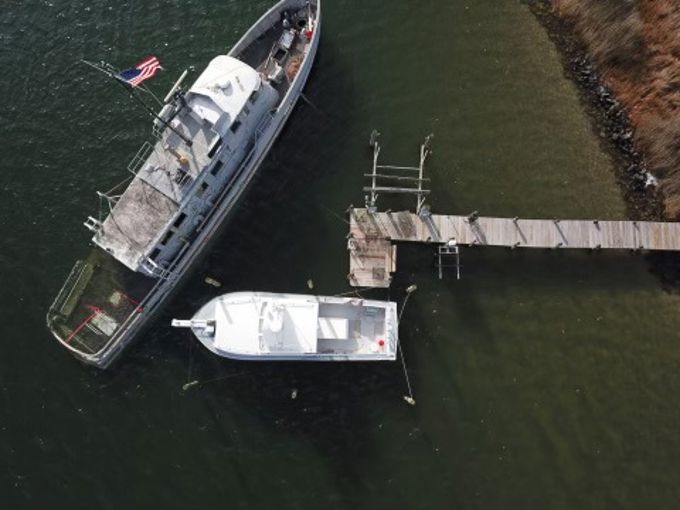
Solving the Dilemma Caused by a Large Abandoned and Derelict Vessel Dumped Next to Our Clients' Pier
A Most Remarkable Result: Tom Berkley Persuades the VMRC to Remove an Abandoned and Derelict Vessel at Government Expense
Our clients turned to us after someone sank and abandoned an 82-foot former U.S. Navy vessel in the Little Wicomico River, right next to our clients’ pier. One of our Waterfront Property Law attorneys, Tom Berkley, persuaded the Virginia Marine Resources Commission to remove the vessel at government expenses. The remarkable result that Tom delivered for these clients is noteworthy because, as explained in our blog post “Protecting Your Virginia Riparian Property Rights & Derelict Vessels”, Virginia law offers no easy solutions. Another pair of our blog posts, “Environmental Law Eliminates a Floating Junkyard (part 1 of 2)” and “Environmental Law Eliminates a Floating Junkyard (part 2 of 2)”, explain the multi-year effort we deployed to help another client eliminate a 30-vessel fleet of abandoned and derelict vessels through federal court litigation.

Only Rarely Will Government Agencies Act to Remove an Abandoned and Derelict Vessel
Abandoned and derelict vessels create a particularly nasty nuisance in the waters of our Commonwealth. They threaten navigation, environmental harm through release of oil and hazardous substances, personal injury, property damage, and a lowering of property value for the waterfront property owner. This type of problem arrives suddenly and without warning, usually because someone without the experience or resources to properly maneuver or maintain a vessel dumps the vessel on or near waterfront property and walks away, similar to the way that some smokers throw down their cigarette butts and walk away. The vessel owner can be difficult to find, once found difficult to communicate with, and in nearly all instances uninterested in taking any responsibility for his or her action. Obtaining meaningful assistance from the various federal and state government agencies, each of whom have ample jurisdiction to address the issue, is frustrating, confusing, and time consuming, usually delivering little if any benefit for the waterfront property owner. The reason for this is that these agencies prioritize their own internal agendas ahead of private individual concern. This leaves unaddressed the nasty problem posed by abandoned and derelict vessels, except for the commendable efforts of a Virginia Beach nonprofit, The Vessel Disposal and Reuse Foundation, for whom our Waterfront Property Law team provides pro bono legal services, along with the effort undertaken by the waterfront property owner at his or her own expense.

The Result That Tom Berkley Achieved in This Situation for Our Client
Our Waterfront Law Team recently navigated the maze of federal and state regulations and laws involving the United States Coast Guard, the United States Army Corps of Engineers, the Virginia Marine Resources Commission, and the Virginia Department of Wildlife Resources to assist our client, a waterfront property owner on the Little Wicomico River in Northumberland County, resulting in the removal, at government expense, of an eighty-two foot former U.S. Navy ship that came aground next to our client’s pier and was left there, abandoned.
How YP 654 Came to Be Abandoned at Our Client’s Property
This abandoned and derelict vessel, known as YP 654, served as a minesweeper and patrol boat for the United States Navy during World War II. In November of 2023, a private individual, who had previously purchased the vessel and committed to restoring it, decided to tow the YP through the narrow Little Wicomico River to a small shipyard using a recreational pontoon boat. Unfortunately, the YP’s owner failed to grasp the complexity of the tow, and, as a result, the heavy vessel broke free and drifted towards shore and its inevitable grounding. At the time, the YP’s hull contained 20,000 pounds of lead ballast and 4 large diesel engines and supported a substantial above deck metal housing. Once grounded the original wooden hull failed, cracked and splintered under the immense weight. The YP partially sank coming to rest in our client’s riparian area, on the state’s bottomland, and in waters subject to both state and federal laws.
Our clients, the new owners of the home immediately adjacent to the YP, soon discovered the vessel spanned their riparian area and blocked any use of their pier, their new yacht, and their waterfront. They had suddenly become divested of all their valuable riparian rights for which they had handsomely paid. (Our blog post “How Riparian Rights Create High Waterfrront Property Prices in Virginia” suggests that our clients likely paid a premium of 25% for their waterfront property on the Little Wicomico River.) They immediately began dealing with the United States Environmental Protection Agency, the United States Coast Guard, and the Virginia Marine Resources Commission (“VMRC”), but they received identical responses – call someone else. They called our Waterfront Law Team.

Tom Berkley’s Strategy Produced Results
Our team quickly learned the owner of the YP had abandoned the vessel and moved out of state in what appeared to be an attempt to avoid criminal prosecution or service of a civil complaint. Working with the police for the VMRC, the Waterfront Law Team assisted with finding the owner and ensuring he returned to Northumberland County for a criminal hearing during which he would answer for his violations of Virginia’s vessel abandonment and pollution laws. Simultaneously, our Team continued communications with the United States Army Corps of Engineers (Norfolk and Baltimore offices), the United States Coast Guard, and the VMRC to search for any financial relief to remove a vessel that threatened pollution and navigational disaster for the community surrounding the Little Wicomico River. Our clients, who did not cherish the thoughts of taking ownership of the wrecked vessel and its many inimical issues through a program overseen by the Virginia Department of Wildlife Management, suffering the expense of removing the vessel from the river and any resulting environmental costs or penalties, or pursuing expensive civil litigation against the YP’s owner, who had already threatened bankruptcy, coordinated with our office in their communications with federal and state legislators and their local newspaper.
Relying on the federal Wreck Act and state vessel abandonment laws, our team then gained the ear of the United States Coast Guard, the United States Army Corps of Engineers and the VMRC. Eventually, the VMRC, which, in 2022, had received $3 million in state funds for an abandoned and derelict vessel removal program agreed to accept an application from Northumberland County to remove the YP. Because this removal program had neither received additional funds in 2023 nor a guarantee of funds for 2024, the increasing number of derelict vessels reports to the VMRC required our clients and our legal team to move quickly to ensure Northumberland County secured approval of its application.
On May 28, 2024, the VRMC by unanimous vote awarded nearly $300,000 to Northumberland County to assist not only with the removal of the YP but also with the restoration of our client’s riparian rights. At the time of the grant, these funds totaled roughly one-third of the quickly shrinking balance of the derelict vessel abandonment program and became the largest vessel removal grant offered by the VMRC.
Conclusion
The attorneys on our Waterfront Property Law Team have strong connections and significant legal experience. As you can tell from the time a few years ago when one of our attorneys stripped off his shoes and got in the water to fend off a criminal enforcement action being filed against our client, we go the extra mile for our clients, if that is what is needed to get the job done.
Contact us if you would like to see us publish more information on the law of abandoned and derelict vessels in the state of Virginia. Of course, you can always contact us for advice and assistance in connection with needs specific to your particular situation.
